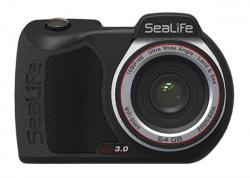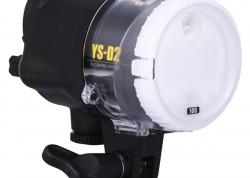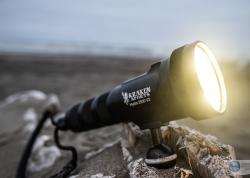Sony A77 DSLR Pre-review
Sony A77 Pre-review
A new type of DSLR, Sony's SLT-A77
By Scott Gietler
Sony has decided to compete with the big boys - the Canon 7D and Nikon D7000, with a new type of dSLR, the Sony A77. Technically it does not have the "R" in DSLR, the reflex, but most people are calling it a DSLR.
By using a translucent mirror instead of a conventional mirror, the Sony A77 is able to use faster phase-detection focusing in conjunction with live-view mode, as opposed to the slower contrast-detection focusing. It offers a 24 megapixel sensor, and offers high-speeding shooting at a shockingly fast 12 frames per second. All these exciting features are creating a lot of buzz around this camera.

Front of the Sony A77 camera
Sony A77 and the pellicle mirror
The translucent mirror in the Sony A77 is called a pellicle mirror. A pellicle mirror does not flip up and down like a conventional mirror. It is translucent and remains in place, with 70% of the light going to the sensor, and 30% going to the electronic viewfinder. This makes the camera almost vibration free, which is ideal for macro and long telephoto photography. Pellicle mirrors have actually been around since the 1960's, and one was used in the Sony SLT-A55. You can read more about pellicle mirrors here and here.
Although it sounds like a lot, losing 30% of the light going to the sensor is not that big of a deal, it is just 1/3 of a stop, which you can easily get back by adjusting your ISO, shutter speed or aperture 1/3 of a stop.
By implementing a pellicle mirror, the Sony A77 can use the superior phase-detection method of focus during high-speed shooting, live view and video, unlike most other DSLRs which must switch to the slower contract-detection, currently used by compact cameras.
Innovative shutter allows 12 fps
By implementing an electronic first-curtain in the shutter, the Sony A77 can acheive shooting speeds of 12 frames per second, and a shutter lag of only 50 milliseconds. Most dSLR cameras shoot at 4-8 frames per second in the high-speed shooting mode, and have a shutter lag of 45 - 85 milliseconds.
New OLED electronic viewfinder
The new OLED (Organic Light Emitting Diode) electronic viewfinder in this camera sure has people talking. It offers a 100% view, and is considereably larger than optical viewfinders on competing cameras. Electronic viewfinders do have nuances that make them different from optical viewfinders, and I highly suggest you try it out for yourself to see how you adjust to it.
24 Megapixels - is it too much?
Some people think 24 megapixels is a lot to cram onto an APS-C sized sensor. One thing for sure, that many megapixels may test the resolving power of some lenses. Diffraction will limit the resolving power also if you use smaller apertures. Stick to high-quality F2.8 lenses to get the best resolutions.
One thing to remember, 24 megapxiels is only a 22% increase over the 16 megapixels in the D7000, and a 16% increase over the 18 megapixels in the Canon 7D, looking along one axis. Not as big of a jump as it seems.
Sony A77 in a nutshell
The Sony A77 offers live view + a high-quality electronic viewfinder, very fast focusing using phase-detection (even during video), an amazing 12fps shooting, 24 megapixel sensor, and continuous autofocus during video.
Back of the Sony ALT-77
Key features of the Sony A77:
- $1400 USD for the body, available Oct 2011. $2000 with a 16-50mm F2.8 kit lens.
- 24 megapixel APS CMOS sensor, same crop factor as NIkon D300s / Nikon D7000; 6000 pixels x 4000 pixels. This is a lot of megapixels, and it is not clear if most users will need this many megapixels. In comparison, even the Canon 7D is only 18 megapixels.
- 2.4 million dot OLED electronic viewfinder. The big question is - is this as good as a optical viewfinder? Probably not, but the verdict so far is that it is fairly close, and better than any other viewfinder out there. This is very high resolution for an EVF. Users report the EVF as “big” compared to a standard DSLR optical viewfinder
- Live view, shown via a 921,000 dot articulating LCD, which is reported to be good in bright light & low light. The tilt-and-swivel feature of the LCD allows you to take photos and videos from many different angles. This is a really nice tool for both video and live-view photography.
- ISO 50 - 16,000, which is quite a good range.
- 12 frames per second still shooting (one of the fastest cameras out there), RAW buffer size of only 13 photos (not good). So after taking 13 shots, you must wait for the buffer to empty to the SD card
- Phase detection focusing during video & stills. Phase-detection focusing is much faster than contrast-detection focusing, which is what compact and micro-four thirds cameras use. In video, this is ONLY in “P” mode; when taking video in P mode, and FYI the lens aperture is usually kept wide-open
- Full 1080p video at 60fps in the AVCHD 2.0 format, with continuous autofocus, but only in P mode. 28Mbps data rate for video, comparable to the Nikon D7000, but less than the 48Mbps data rate for the Canon 7D.
- 19 auto-focus points
- Max shutter speed 1/8000 sec shutter speed, 1/250 sec flash sync
- Built in GPS. Great feature, but I hope it can be turned off.
- Built in image stabilization, 2.5 to 4 stops supposedly gained
- Only a single slot for SD memory cards is supported. Compact flash cards are faster.
Here is a size comparison with D300, D7000, Canon 7D. As you can see, it is slightly larger than the D7000, slightly smaller than the Nikon D300 & Canon 7D
Videos showing the Sony A77
If you ignore all the acronyms and hyped-up Sony marketing terms, this video gives a nice overview of the Sony A77. They even pour water over the camera in the video.
In this short video below, you can see the articulated LCD of the Sony A77:
High ISO Noise
I downloaded the full-size ISO 6400 sample from DPReview, and it looked quite good to me at 100% magnification. Other technical reviews reported the high ISO performance to be close to, but not as good as, the high-ISO performance of the Canon 7D and Nikon D7000.
Here's a photo at ISO 6400, 1/40th, F8. There's a link at the bottom of the page for a full-res version you can zoom in on.
Can Sony cram 24 megapixels on an APS-C sensor and not have excessive noise? They appear to have used generous noise reduction. As of now, the jury is out regarding how acceptable the noise is on this sensor. Sony tends to use fairly heavy noise reduction in their jpegs.
The sensor is only getting 70% of the incoming light, because the translucent mirror is reflecting the other 30%.
One thing for sure - the amount of noise in a photo is in the eye of the viewer.
Online pre-reviews on the Sony A77
DPReview also reports that the image is cropped even further in movie mode. This sounds a little strange to me. Rumor has it the battery only lasts for about 450 shots, which isn’t great. Comments on the DPReview test images are mixed, so check them out for yourself.
There is an in-depth review on Imaging Resource, who says "Making a major leap in the camera market, the Sony A77 reaches into pro territory, able to capture 12 frames per second with a 24.3-megapixel camera that feels great and handles like your typical enthusiast digital SLR. Its optional 16-50mm kit lens also delivers excellent quality for the money".
Luminous landscape says "This along with the fact that the A77 has continuous Live View, and no moving mirror because of its Translucent Mirror technology, means that the A77 will likely be one of the most vibration free cameras ever made. This will make it ideal for macro, microscope, long telephoto and telescope work."
Sony SLT-A65
Sony also introduced the SLT-65, which we are not a huge fan of, due to the 1/160th sync speed, making wide-angle shots into sun more difficult. However, some people may be attracted to the $900 price for the body.
Key differences with from the Sony A77:
- Plastic body. and missing weather seals
- Shoots at 10fps
- 15 auto-focus points instead of 19
- 1 control dial instead of 2
- 1/4000th shutter speed instead of 1/8000th
- Sync speed of 1/160th instead of 1/250th
Lenses for the Sony A77
A complete list of lenses for the Sony A77 can be found here. There is a fairly complete set of lenses available for underwater photography.
Sigma, Minolta and Tamron all make a wide-range of lenses, including macro, wide-angle, and fisheye lenses. Lenses like the Sigma 10-20mm, Sigma 17-70mm, Sigma 10mm fisheye and Sigma 15mm fisheye will work well for underwater photography.
For macro photography, you have the Sigma 70mm F2.8 macro, and the Sony 100mm F2.8 macro as good choices, that are full-frame lenses with autofocus motors built-in.
However, there is no Sony mount for the Tokina 10-17mm fisheye lens.
For wildlife and sports photography, Sigma makes a consumer grade 120mm-400mm F4.5-5.6 lens, and Tamron, Sony and Sigma all make 300mm F2.8 prime lenses. There are also a couple discountinued 400mm, 500mm and 600mm prime lenses for those with larger budgets.
Further Reading
Pixels and Sensor size
Lens basics
Understanding ISO
RECOMMENDED ARTICLES
SUPPORT THE UNDERWATER PHOTOGRAPHY GUIDE:
The Best Service & Prices on u/w Photo Gear
 Visit Bluewater Photo & Video for all your underwater photography and video gear. Click, or call the team at (310) 633-5052 for expert advice!
Visit Bluewater Photo & Video for all your underwater photography and video gear. Click, or call the team at (310) 633-5052 for expert advice!
The Best Pricing, Service & Expert Advice to Book your Dive Trips
 Bluewater Travel is your full-service scuba travel agency. Let our expert advisers plan and book your next dive vacation. Run by divers, for divers.
Bluewater Travel is your full-service scuba travel agency. Let our expert advisers plan and book your next dive vacation. Run by divers, for divers.
































